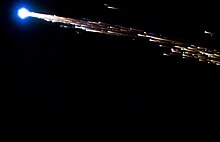Reentry Breakup Recorder

The Reentry Breakup Recorder (REBR) is an instrument on board a spaceship that records data about its planned breakup when it reenters the earth's atmosphere. The device collects data on the heat, acceleration, rotation and other loads that the vehicle is subjected to. In the final stage, it transmits the data to a ground station before it is destroyed when it hits the surface.
history
Two REBRs started in 2011 with the Japanese HTV-2 . One then recorded the re-entry of the HTV, the other was placed on board the ATV-2 .
HTV-2 re-entered the earth's atmosphere on March 30, 2011. The REBR successfully collected and sent data. It survived the impact on the ocean and continued to transmit data thereafter. The evaluation of the data took 8 weeks.
The second unit was scheduled to collect data on the re-entry of ATV-2 on June 21, 2011. For an unknown reason the device could not establish contact and therefore no data could be received.
Another unit was successfully deployed on re-entry on September 14, 2012 in HTV-3 .
On October 3, 2012, the re-entry of the ATV-3 was successfully recorded.
Predecessor technology: image documentation of re-entry and break-up
Previously, the data collected on re-entry and break-up came from visual observations and spectrographs . A particularly well-documented case occurred over the South Pacific in September 2008, in pursuit of the first mission of the ESA space transporter ATV-1 Jules Verne . Extensive photo and video data from various wavelength spectrographs were collected by a large team of NASA and ESA personnel.

On September 5, 2008, Jules Verne undocked from the ISS and maneuvered to an orbital position 5 km below the ISS. It remained in that orbit until September 29th. At 10:00:27 UTC , Jules Verne started the first de-orbit burn for 6 minutes, followed by a second burn of 15 minutes at 12:58:18 UTC. At 13:31 GMT , Jules Verne entered the atmosphere at an altitude of 120 km and, as planned, completed its devastating re-entry after 12 minutes as the remains fell in the South Pacific southwest of Tahiti . This was recorded with video and photo recordings during the night from two aircraft over the South Pacific for the purpose of data collection.
Web links
- Photo and diagram of the first REBRs , April 2011.
Individual evidence
- ^ A b Staff Writers: Unique Aerospace Invention Ready For Debut. Space Travel.com, March 29, 2011, accessed August 3, 2014 .
- ↑ Spacecraft reentry breakup recorder - United States Patent 6895314. Free Patents Online, May 17, 2005, accessed August 3, 2014 .
- ↑ Breakup Recorder Hits Ground Running. In: Space Ref.Aerospace Corporation, March 30, 2011, accessed August 3, 2014 .
- ^ Daniel: End of mission. In: Georges Lemaître - Follow ESA's Automated Transfer Vehicle missions to the ISS. ESA, June 21, 2011, accessed August 3, 2014 .
- ^ Daniel: Follow-up on the Reentry Breakup Recorder. In: Georges Lemaître - Follow ESA's Automated Transfer Vehicle missions to the ISS. ESA, June 24, 2014, accessed August 3, 2014 .
- ↑ John Love: Lead Increment Scientist's Highlights For Week of Sept. 10, 2012. NASA, September 21, 2012, accessed August 3, 2014 .
- ↑ Jonathan Amos: 'Jules Verne' begins final voyage. In: BBC News. BBC, September 5, 2008, accessed August 7, 2014 .
- ^ Successful re-entry marks bright future for ATV. ESA , September 29, 2008, accessed August 7, 2014 .
- ↑ Image of the Day Gallery - October 6, 2008. NASA, accessed August 8, 2014 .
